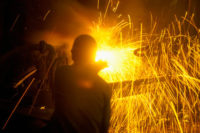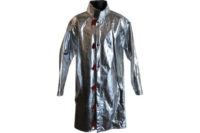On the positive side, more and more companies are recognizing the need to provide improved personal protective equipment (PPE) for their employees and the availability of new technologies to help them do this. Safety managers are realizing that no threat, risk or hazard is too small to overlook. Even a brief moment of exposure on a job site could change a worker’s life forever. Therefore, an increasing number of companies want to equip their employees with better head-to-toe protection.
But this can be a difficult goal to achieve at a time when budgets are tight. Many safety managers find themselves in the quandary of providing workers with the highest level of protection possible at the lowest cost. Nearly always, the best products on the market and those that provide the most overall value are not the cheapest.
Standards fall short
Often safety managers take the easiest course: implement inexpensive solutions that meet industry standards. While they can be a good starting point for evaluating protective fabrics, industry standards fail to cover all aspects that should be considered when purchasing protective clothing. Industry standards are typically minimum compliance bars and are broadly written and intended to be inclusive, not exclusive. For example, the industry’s “No Melt, No Drip” requirements only mandate that protective fabrics not contribute to burns in a thermal exposure; they don’t actually require fabrics to offer any protection to the wearer.
As government scrutiny of workplace conditions increases, industry standards are continually being evaluated and improved. Insurance companies are also driving proper PPE usage, often offering reduced premiums to “full safe” companies.
Meeting multi-tasking needs
Another reality in many industrial workplaces is a trend toward staffing “cross-functional” employees. As more processes have become automated, many workers are now performing multiple tasks across functions in their facilities. With this crossover in their day-to-day responsibilities, workers may come in contact with several hazards and risks in one shift.
To meet the needs of workers operating across multiple environments with varying risk levels, different fibers and fabrics are being developed that offer multifunctional protection. Multiuse protective fabrics can sometimes offer safety managers a “one solution fits all” option for selecting protective clothing. These fabrics provide consistent protection for workers across a number of hazardous environments, enabling a level of standardization to be achieved and limiting the number of protective garments that are required to outfit workers. Such standardization can also help reduce confusion among employees, especially new hires, as they try to maintain compliance in different zones.
Multiuse protective fabrics are designed to protect against numerous types of hazards in one single garment. Performance features of these fabrics in hot environments include: flame resistance; resistance to molten metal, petrochemicals and other flammable liquids; radiant heat protection; arc flash protection; protection against harsh weather conditions; comfort and functionality; and durability. Protective fabric and clothing manufacturers are challenged with developing solutions that can satisfy all of these performance requirements.
Protect against direct flame
Perhaps the most important attribute of a protective fabric in an environment subject to thermal risk is its flame resistance. Truly non-flammable protective fabrics (as opposed to purely flame-resistant fabrics) offer the highest level of protection. They will not burn, melt or ignite when exposed to direct flame. Even after intense exposure, they maintain their strength and integrity and continue to protect.
A good test for flame resistance is the Vertical Flame test for After Flame. There are protective fabrics on the market that have 0 seconds After Flame, which far surpasses industry standards requiring 2 seconds or less.
Protect against molten metal, petrochemicals and hot liquids
Some new fiber blends include proprietary compounds that enable fabrics to better shed molten metal, petrochemicals and hot/flammable liquids. Sparks and spatter simply roll off the material, making it ideal for use in outerwear applications designed to defend against these hazards, like jackets, sleeves, coveralls, aprons, bibs and spats.
The ASTM F955 Pour Test demonstrates and quantifies a protective fabric’s resistance to contact with molten metal and its ability to prevent a theoretical second-degree burn. There are multiuse protective fabrics as light as 8.5 oz/yd2 able to pass the pour test for molten iron and aluminum.
Protect against radiant heat
Multiuse protective fabrics may be aluminized to enhance protection against radiant heat. These fabrics protect against both radiant heat and molten metal splash at a fraction of the weight of other alternatives in use, and they offer significantly improved flexibility.
Protect against arc flash
There are lightweight multiuse protective fabrics available that are rated NFPA 70E Hazard Risk Category 2 or higher (lighter weight fabrics typically fall into category 1). These fabrics can also have arc ratings over 9 cals.
Protect from the elements
A recent advancement in multiuse protective fabrics is including an encapsulated barrier of silicone that can help shield a worker against harsh weather conditions, reduce wind penetration, and repel water.
Comfort and functionality
The weight of a fabric plays a significant role in wearer comfort, and lighter weight solutions are constantly being developed to minimize the physiological load on the wearer. New multiuse protective fabrics can be up to 60 percent lighter than traditional protective options. This lighter weight increases a wearer’s comfort and productivity as it decreases the amount of muscle exertion and heat stress that builds up over the course of a work shift.
Lightweight protective apparel allows workers to wear multiple layers when undertaking hazardous tasks. Layering is an optimal and flexible solution to increase protection while maintaining comfort.
Durability
High-quality multiuse protective fabrics are inherently flame resistant, meaning that their thermal protective properties will not wash out or wear away. Protective clothing made from these fabrics can be worn again and again, even under conditions of daily exposure, and can withstand multiple laundry/dry cycles. This long service life provides significant value to users.
Multiuse protective fabrics may be considered a mid-point between having no PPE in place and providing expensive high-risk garments for all workers, even those who do not need this level of protection. Their affordability and performance features provide a high level of overall value — a critical consideration for companies making PPE decisions in the current economy.



